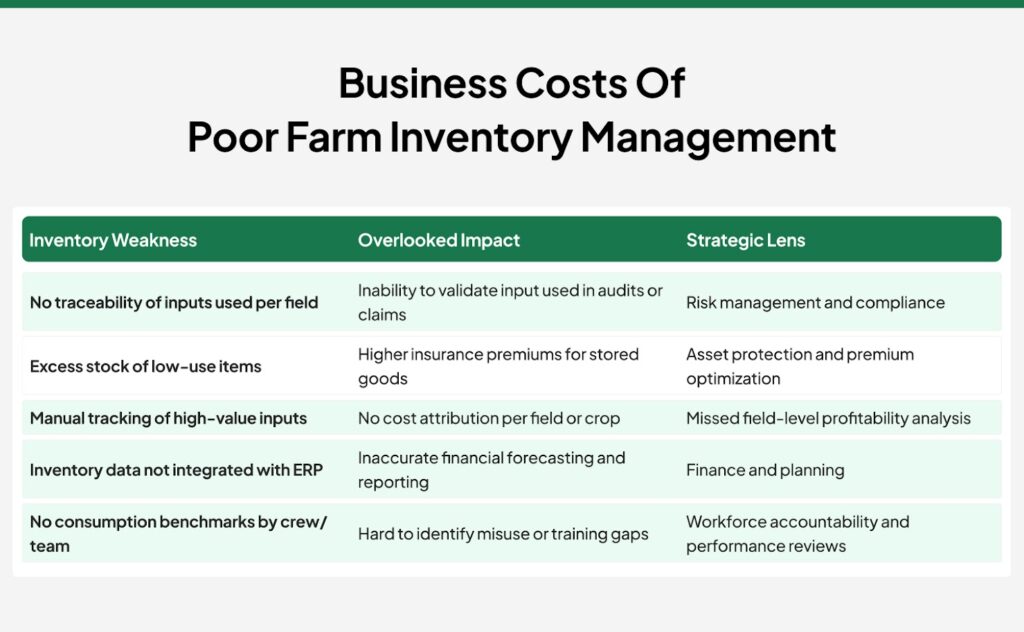Inventory mistakes on farms often go unnoticed until they cost you. Whether it’s running short on fertilizer mid-season or losing track of feed quantities, a lack of systemized tracking leads to inefficiencies that quietly drain profitability. In an industry where inputs are time-sensitive and margins are tightening, farm inventory management is not just an operational task; it’s a business-critical process.
As farms grow more complex, managing stock across multiple storage locations, production areas, and seasonal timelines requires more than manual logs. The Best farm inventory management systems bring structure to this chaos by aligning inventory data with purchasing, usage, and planning. They help reduce waste, avoid costly delays, and give farmers control over one of the most variable parts of their operation.
This blog explores how inventory directly impacts profitability and productivity, what tools and practices successful farms are adopting, and how to build a process that works, whether you’re running livestock, row crops, or mixed operations.
What is Farm Inventory Management?
The process of monitoring crop health, recording, and controlling all physical assets and consumable items used on a farm is referred to as farm inventory management. This includes seeds, fertilizers, pesticides, feed, fuel, equipment parts, packaging supplies, and even harvested products stored for distribution or processing. The goal is to ensure that the right quantity of inputs is available at the right time, without excess stock tying up cash or unused inventory going to waste.
Unlike general inventory systems used in retail or manufacturing, farm inventory management must account for unique agricultural variables such as seasonality, perishability, usage variability, and storage limitations. For instance, a delay in herbicide application due to a missing item in inventory can directly impact crop yields and profitability.
Important Tip:
Audit high-turnover items monthly, not seasonally; small discrepancies in seed, feed, or fuel often reveal costly patterns hiding in daily operations.
This adds value by:
- Giving a specific frequency (monthly vs. seasonally)
- Highlighting a category of items readers likely overlook
- Encouraging action that leads to immediate operational insight
Farms often struggle with inventory due to unstructured agriculture inventory tracking, a lack of real-time visibility, and unpredictable usage patterns, factors that quietly affect efficiency long before they are recognized.
Where Inventory Really Breaks Down on Farms
On the surface, inventory issues might look like a simple matter of missing products or overordering, but the deeper consequences run through the core of farm operations, affecting margins, decision-making, and the ability to respond in time-critical moments. Here’s where farm inventory management often falls apart, and what it really costs.
1. Unaccounted Inventory Shrinkage
Farms often don’t track inventory shrinkage the same way warehouses do, but product loss from evaporation, spillage, spoilage, or theft can accumulate quickly, especially in bulk-stored inputs.
Business impact: Unexplained inventory loss drives higher reorder frequency and inflates cost per acre.
Introduce periodic physical counts and variance tracking between expected and actual stock levels. Assign accountability by location or team lead.
2. Disconnected Procurement and Usage Rates
Reordering is often reactive, based on intuition or habit rather than actual consumption trends. This leads to overstocking slow-moving items and understocking season-critical supplies.
Business impact: Tied-up working capital in non-moving stock; missed planting or treatment windows.
Use historical usage data and forward planning (crop calendar, field size, application rates) to drive ordering, moving from a push to a pull model. A well-implemented farm ag inventory management software can make this seamless without disrupting daily workflows, also highlighting the benefits of workflow management in streamlining operations and improving decision-making.
3. Lack of Cross-Site Visibility
Many farms manage inventory in silos, each barn, shed, or crew keeps local records or verbal notes. No one has a consolidated view. Without unified access to essential farm record-keeping details, such as stock levels, usage history, and reorder points, teams often duplicate orders, miss shortages, or struggle to coordinate timely applications across sites.
Business impact: Duplicate orders, wasted delivery runs, and underutilized existing stock.
Centralize agriculture inventory tracking with location tagging. Even a simple shared spreadsheet or app can prevent costly redundancy.
4. No Expiry or Lot Tracking for Inputs
Inputs like seed, fertilizer, and crop protection chemicals have shelf lives and batch differences that affect performance.
Business impact: Poor efficacy, failed treatments, and regulatory compliance risks.
Track lot numbers and expiration dates at intake, and rotate stock using FIFO (First In, First Out) to minimize waste. McKinsey research highlights that monitoring silo and warehouse levels can enable automated reordering, cutting inventory costs and extending input shelf life. Smart storage tools can also help reduce post-harvest losses by optimizing conditions in real time.
5. Labor Wasted on Stock Checks and Guesswork
When crews have to walk, call, or wait just to confirm stock status, it’s silent labor leakage. When teams spend time walking between sheds, calling for updates, or guessing what’s in stock, valuable labor and time is wasted on inefficient tasks.
Business impact: Lost productive hours, delayed machinery use, planning frustration.
Enable mobile or voice-based stock lookups for crew leads, with real-time syncing across the operation.

What Should You Track, and Why Accountability is the Backbone of Farm Inventory Management
One of the most common reasons farm inventory management fails is that no one knows what exactly needs to be tracked or who is truly responsible. It’s not just about keeping tabs on how much inventory is left. You need to know where it is, how it’s being used, and who is monitoring it. Without that structure, even the best-stocked operation can slip into disorganization.
Inventory That Impacts Your Operation Daily
Here’s what must be tracked to keep your farm efficient and your costs under control:
- Inputs like seed, fertilizer, pesticides, and animal feed. These drive your production cycles, and missing them at the wrong time means stalled growth or crop loss.
- Daily-use supplies such as fuel, protective equipment, and other day-to-day materials. These are essential to keep machinery running and teams protected.
- Harvested outputs or livestock, including raw fresh produce using fresh produce ERP, processed goods, stored grain, or herd. Tracking this accurately affects forecasting and revenue projections.
Pro Tip: Don’t just count what you have, track where it’s stored. Farm operations waste hours searching for supplies simply because there’s no location reference.
The Role of Technology
Even the most dedicated staff can only do so much without the right system. Folio3 AgTech’s farm inventory management software helps consolidate all categories into a single platform, giving every stakeholder access to real-time data. When combined with mobile access or barcode scanning, a farm inventory management tool eliminates guesswork and provides clarity across the entire operation.
If you’re managing multiple facilities, expanding your acreage, or running year-round operations, leveraging technology is no longer optional; it’s essential.
Innovative farm inventory management isn’t just about stock levels. It’s about visibility, responsibility, and control across every touchpoint in your supply chain management as well.
Best Practices for Effective Farm Inventory Management
From reducing waste to maintaining traceability and keeping procurement lean, farm inventory management must be strategic, not reactive. Below are actionable best practices that move beyond theory and are used by high-performing farms to stay ahead.
1. Start With a Standardized Intake Process
Most inventory inconsistencies begin the moment items arrive on the farm. Whether it’s seeds, chemicals, or equipment parts, failing to log them properly leads to misplaced materials and distorted stock data.
Establish a routine intake protocol: record the quantity, input supplier details, document expiry dates or batch numbers, and assign precise storage locations with a farm record-keeping software. Use barcode scanning or digital entry to avoid manual errors and ensure real-time updates across your operation.
Quick Tip: Label all incoming stock with its delivery date and assign categories as soon as possible. Don’t let it sit unlogged for even a day.
2. Establish Usage Thresholds for Auto-Replenishment
For mission-critical supplies like fuel, fertilizers, or PPE, establish reorder thresholds based on usage trends and seasonal needs.
Set low-stock alerts or automated reorder points using your farm inventory management tools. This not only avoids stock outs, but also helps negotiate bulk pricing by ordering ahead of peak demand cycles.
3. Track Inventory Movement
Instead of only logging what’s in storage, track how items move across teams and locations, from warehouse to farms to the field.
This provides context for your data and helps prevent misreporting or misuse. It’s where farm inventory management truly becomes operationally useful.
4. Rotate Inventory Using Expiry-Based or FIFO Logic
Items like seeds, vaccines, and certain chemicals degrade over time or expire; using them late can impact yield or safety.
Organize storage to follow FIFO (first-in, first-out) logic. Arrange stock physically to promote rotation — oldest upfront, newest at the back. Regularly check for nearing-expiry items and create alerts for timely usage or disposal.
5. Grant Role-Based Inventory Access
Set access levels in your farm inventory management tools to avoid confusion, accidental edits, or overuse.
6. Integrate With Your Farm Operations
Inventory shouldn’t exist in a silo. Sync it with managed procurement, planting, irrigation, and harvest schedules. A well-integrated farm inventory management workflow helps you align purchases with actual need and timing.
Conclusion
Efficient management of farm inventory is a crucial element for a profitable and smooth-running agricultural operation. Overlooking the details of what’s on hand, from fertilization for optimal growth to cattle feeding, can lead to unnoticed expenses and operational inefficiencies. Research demonstrates that farms with effective inventory tracking gain better control over costs and improve their overall efficiency. It’s about moving beyond guesswork to a more informed and strategic approach to resource planning and management.
Modern agricultural technology offers powerful solutions, with specialized farm inventory software leading the way. These solutions provide clear visibility into stock levels, help prevent critical shortages, and enhance coordination across farm activities. Farms adopting these systems experience less waste, fewer costly delays, and improved management of their essential resources. This technological integration is becoming increasingly pivotal for farms of all sizes aiming to optimize their operations and maintain a competitive edge in today’s agricultural landscape.
In conclusion, implementing well-defined farm inventory management practices, supported by user-friendly technology, is essential for building a sustainable and profitable agricultural business.
FAQs
Is Inventory Tracking Still Relevant For Small-Scale Farms?
Absolutely. Even smaller farms face supply issues, input waste, and storage inefficiencies. Tracking inventory, even through basic digital tools, can help reduce overspending and improve decision-making.
What Features Should I Look For In Farm Inventory Software?
Look for real-time syncing, mobile access, input categorization, intuitive dashboards, and the ability to integrate with purchasing or field operations. These features help simplify processes and support better planning throughout the year.
How Often Should Farm Inventory Be Reconciled?
Ideally, perform a complete inventory reconciliation quarterly, with rolling spot-checks weekly or biweekly for high-turnover items. This balance maintains accuracy without disrupting daily operations and helps flag issues before they escalate.







